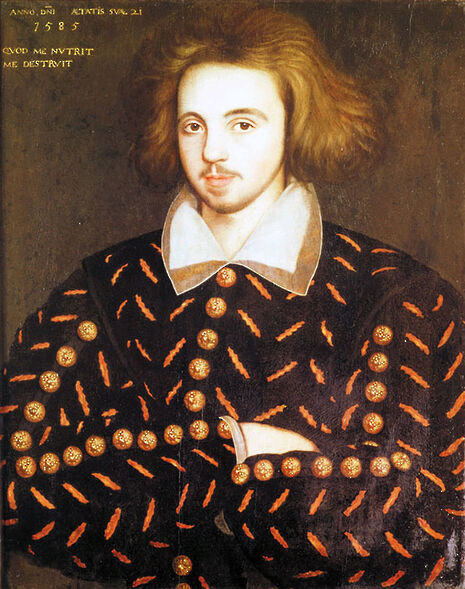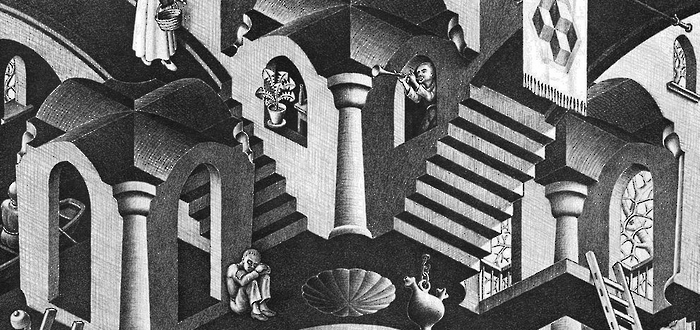What feeds me, destroys me: Christopher Marlowe and Corpus Christi
The chance recovery of a portrait at Corpus Christi in 1952, is the springboard from which Joseph Krol launches his musings on time, legacy and artistic representation

Time is at once both a beautiful and a sickening thing. It is moving ever forwards, without respite, yet so often it seems to come back on itself, ploughing anew the furrows of centuries past. All these heartstrings at the centre of time’s nature seem to me to have interweaved hauntingly in one chance discovery, some 70 years ago.
In 1952, Corpus Christi was in the throngs of a college-wide renovation, just as it is today. It must have resembled something of a building site: a large skip had been left in the middle of Old Court. A passing student heading back to his room saw a couple of pieces of wood sticking out of the top. He took them both with him, thinking them useful for putting together a stand for his new hi-fi system.
What he held in his hands was, in fact, much more important. These two oak planks turned out to be two halves of a broken, blackened portrait, about 18 by 24 inches, depicting a dimly foppish figure in Elizabeth attire.

The chap does look a lot like Christopher Marlowe. But then, I suppose, it would, it being the only putative likeness of him to have survived. Despite any real documentary evidence, it is indeed almost universally said to show the Corpus-educated playwright. There are, to be fair, decent grounds for this. The following restoration uncovered a scribbled note on the portrait, saying that the subject was 21 when the work was painted in 1585, as Marlowe was. Additionally, it was apparently found stuck under an ancient fireplace in a room that was formerly part of the Master’s Lodge, where a number of portraits of Elizabethan luminaries had once hanged. Beyond this, we are reduced to making educated guesses based on the man’s appearance: does he not look dramaturgically rakish? Does he not seem the sort of dandy to get involved in theatrics?
“As we try to memorialise a man whom none of us could remember, we must recall that our lives are as fragile as those that have gone before us”
There is, however, one more clue to work with, even if it seems submerged in a mire of writhing ambiguity. It is the sitter’s motto, painted onto the canvas: ’Quod me nutruit, me destruit’ - ‘What nourishes me, destroys me’.
The aphorism seems to plead with time itself. Time courses through our lives as blood through our veins, yet it must stop the noblest heart at the end of it all. It reduces great people to a questionable daubing on a hearth stand; it shreds the works and days of man, and scatters the remnants in the autumn winds.
It seems a quintessentially Cantabrigian attitude to focus so much on the man behind his works, to cling desperately to the coat-tails of the past long after any relevance has passed. It is easy to forget in an environment such as this that facts erode as readily as does a riverbank. As one signs one’s name into the matriculation books, as one attains countless presidencies, as one discovers the idiosyncrasies of Cambridge life, it can feel like these actions are linked unfailingly to history; indeed, it can feel as if real history is being made by our actions.
But even the greatest luminaries of our time may soon be recalled only in a strange, warped manner; their works may last, but their souls cannot. Of the sweeping majority, even in a place such as this, scarcely a mark will be left on the future. Perhaps this is pessimistic; perhaps modern times will prove different. It is disheartening to note, however, that the name of that very undergraduate who first found the portrait has since been forgotten.
As we try to memorialise a man whom none of us could remember, we must recall that our lives are as fragile as those that have gone before us. Within a decade, this man’s personality was barely a dozen flickering candle-lights in the memories of those who still recalled him. Within a century, it was a shadow skulking in the twilight of reality. By now it is but fading ink on parochial records. Nothing beside remains; no portrait can really change this.
We are left with little more than strange caricatures spun from impersonal records – shaky sketches of a violent death, smoky depictions of a tempestuous writing career – that are scarcely more credible than the alleged portrait itself. If this is how time treats those who are remembered, one might prefer to be forgotten
 Interviews / You don’t need to peak at Cambridge, says Robin Harding31 December 2025
Interviews / You don’t need to peak at Cambridge, says Robin Harding31 December 2025 Comment / What happened to men at Cambridge?31 December 2025
Comment / What happened to men at Cambridge?31 December 2025 News / Unions protest handling of redundancies at Epidemiology Unit30 December 2025
News / Unions protest handling of redundancies at Epidemiology Unit30 December 2025 Features / ‘Treated like we’re incompetent’: ents officers on college micromanagement30 December 2025
Features / ‘Treated like we’re incompetent’: ents officers on college micromanagement30 December 2025 News / Varsity’s biggest stories of 202531 December 2025
News / Varsity’s biggest stories of 202531 December 2025










